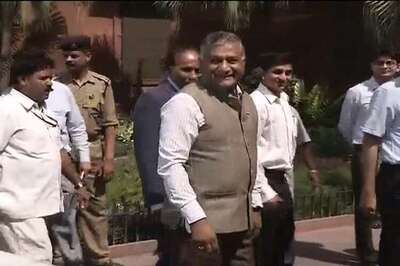
views
New Delhi: As curtains come down on what is likely to be the end of his active professional career, outgoing Governor of Jammu and Kashmir NN Vohra, who was replaced by Satya Pal Malik on Tuesday, will perhaps be remembered for being a low-profile bureaucrat who enjoyed respect by J&K’s political leadership. And as the man New Delhi often turned to in times of crisis.
Narinder Nath Vohra, a 1959 batch IAS officer of the Punjab cadre, has been a lifelong bureaucrat, his career stretching from 1959 till 1994. He served as the Principal Secretary to then prime minister IK Gujaral from 1997 to 1998. He has also served as the Home Secretary, Defence Secretary and the Defence Production Secretary of India.
Vohra had a significant exposure to the situation in Jammu and Kashmir before taking on the job of the Governor in 2008. Back in 2003, he was appointed as the Centre’s interlocutor to Jammu and Kashmir, a position he held till his appointment as the state’s Governor. His tenure as the Centre-appointed interlocutor gave him five years of exposure to various mainstream and separatist leaders in the Valley.
This experience came in handy when he replaced the then governor of the state, retired Army general SK Sinha, at the peak of the Amarnath Shrine land transfer row. Fourteen people were killed and hundreds of protestors were injured during the 60-day agitation that brought the state to its knees. Vohra, right after his appointment, rescinded the controversial order that transferred 99 acres to Amarnath Shrine, cooling down tempers in the Valley significantly.
In his subsequent tenure, Vohra dealt with one crisis after another; the 2010 Kashmir unrest, in which 112 people, mostly young boys, died, and the unrest in 2013 following the hanging of Afzal Guru. Vohra also presided over the general and state elections in 2014, which saw a good percentage of voter turnout. Recognising his talent and vast experience, Vohra was among the very few governors who were not replaced after the new government under Narendra Modi came to power in 2014.
His experience in dealing with Kashmir, his tenure as secretaries of Home and Defence, and his expertise in internal security, were put to severe test during the unrest following Hizbul Mujahideen commander Burhan Wani’s death. In months that followed, when political workers from nearly every party were deserting their hometowns and taking refuge in Srinagar, Vohra’s experience in crisis-management was once again called into play.
In the security review meetings that are held between the Governor, Chief Minister, and senior officers of police, Army and CRPF, NN Vohra’s word is said to have carried tremendous weight, even more than Mehbooba Mufti’s, when it came to preparing strategies in dealing with insurgency.
And again when the BJP pulled out of its working coalition with the PDP on June 20, Vohra’s tenure, which was to end eight days later, was extended to maintain continuity while the state Assembly remained in suspended animation, and to let him preside over the tricky Amarnath Yatra period, which was in the crosshairs of many terror groups.
Vohra and New Delhi had of late been developing a difference of opinion on several issues, the most severe of which was on Article 35A. Vohra had reportedly written a letter to Union Home Minister Rajnath Singh, saying that the issue of Article 35A should not be dealt with till a popular government has been formed.
Governors have been at the helm of affairs in Kashmir since March 1977 when Indira Gandhi pulled out support from the coalition government she was running with Sheikh Abdullah. Then governor, Cambridge-educated economist LK Jha, led the state for 107 days. Since then, seven more spells of Governor’s Rule have been in place in the state, including the longest — the six-year spell from 1990 to 1996 — when the state suffered its bloodiest phase, the exodus of Kashmiri Pandits, a full-scale Pakistan-backed insurgency and heavy deployment of forces.
The Governor’s chair in Kashmir has always been arguably one of the most challenging gubernatorial assignments in the country. As the new Governor, Satya Pal Malik, the first political appointment since Karan Singh’s back in 1952, takes over his new job, he’ll have his hands full with the row over Article 35A, rising insurgency, upcoming Panchayat elections and a suspended state Assembly. For Malik, the former governor of Bihar, filling in NN Vohra’s shoes will be a huge task, given that he has little direct exposure to the state that he’ll be running almost single-handedly for at least a few months. “Regaining the trust of the common man" was the biggest priority, Vohra had said in an interview to a newspaper earlier this year. Malik can afford to waste little time in grasping this heavy baton from his predecessor.




















Comments
0 comment